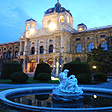GRIECHENBEISL
AND THE TWELVE APOSTLES
Quirky Historic Pub Restaurants of Vienna
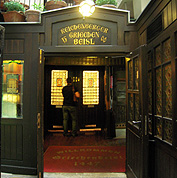 Vienna’s gastronomy is probably best known for its café life,
airy restaurants of coffee and sweets, watching the progress of busy
passersby from your window or street curb table, but two of Vienna’s
most traditional and famous of dining and drinking establishments are
underground, or nearly – and boast associations one may find unusual
for some of the best food and drinking establishment of old Vienna – the
plague and the bible.
Vienna’s gastronomy is probably best known for its café life,
airy restaurants of coffee and sweets, watching the progress of busy
passersby from your window or street curb table, but two of Vienna’s
most traditional and famous of dining and drinking establishments are
underground, or nearly – and boast associations one may find unusual
for some of the best food and drinking establishment of old Vienna – the
plague and the bible.
Griechenbeisl and Augustin
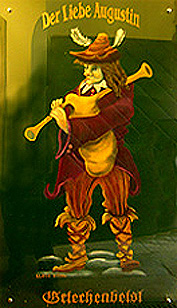 “Ach,
du Lieber Augustin, Augustin“ may be the first words in German
an English speaking child learns, from the nursery rhyme song, which
like many connected to darker historic events, comes from the time Vienna
suffered the ravages of the Bubonic Plague. The legend of
Der Liebe Augustin (Dear Augustine) is that he was a strolling minstrel
singer who got drunk and fell asleep on the street. He was mistaken for
a plague
victim and thrown into a pit with the other dead. Before he could be
covered with lime and buried, he awoke from his stupor and climbed out
of the grave. He didn’t get the disease despite his being tossed
among the infected and his luck became a symbol of hope and Vienna's
ultimate triumph and survival over the plague. The little song
appeared in 1679
about how Augustin lost everything, and it is still sung by children
today.
“Ach,
du Lieber Augustin, Augustin“ may be the first words in German
an English speaking child learns, from the nursery rhyme song, which
like many connected to darker historic events, comes from the time Vienna
suffered the ravages of the Bubonic Plague. The legend of
Der Liebe Augustin (Dear Augustine) is that he was a strolling minstrel
singer who got drunk and fell asleep on the street. He was mistaken for
a plague
victim and thrown into a pit with the other dead. Before he could be
covered with lime and buried, he awoke from his stupor and climbed out
of the grave. He didn’t get the disease despite his being tossed
among the infected and his luck became a symbol of hope and Vienna's
ultimate triumph and survival over the plague. The little song
appeared in 1679
about how Augustin lost everything, and it is still sung by children
today.
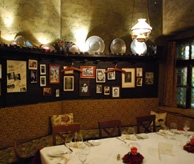 The
Griechenbeisl is Vienna’s oldest and most historic restaurant,
consisting of cramped small dining rooms underneath a remnant of the
former medieval walls of the city topped by a gothic tower first known
as a public house as early as 1447. The restaurant
serves a wide
menu of
traditional
Viennese cuisine
with local wines and the Pilsner beer for which it is well recognized.
The atmosphere retains its middle-ages character, but is best
known for its Mark Twain Room, where the great personages who have lived
in or visited Vienna like Richard Wagner, Mozart, Beethoven, Strauss
and Schubert, as well as the great American story teller for whom it
is honored, have left their marks on its walls and ceilings.
The
Griechenbeisl is Vienna’s oldest and most historic restaurant,
consisting of cramped small dining rooms underneath a remnant of the
former medieval walls of the city topped by a gothic tower first known
as a public house as early as 1447. The restaurant
serves a wide
menu of
traditional
Viennese cuisine
with local wines and the Pilsner beer for which it is well recognized.
The atmosphere retains its middle-ages character, but is best
known for its Mark Twain Room, where the great personages who have lived
in or visited Vienna like Richard Wagner, Mozart, Beethoven, Strauss
and Schubert, as well as the great American story teller for whom it
is honored, have left their marks on its walls and ceilings.
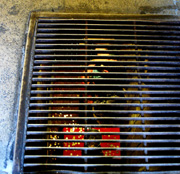 The
restaurant gets its name from the Griechen Gasse street where it is located,
being in the one time slums of the middle-ages where
Greek refuges
settled
in
the
1770s,
and
the
poorer
section of town where Augustin would have stayed, having lost all
his possessions after being dumped in the plague pit – and where
he can still be found today! The Greichen Beisl is tucked into a cobblestone
alleyway
just around the corner from the very busy central Swedenplatz U-Bahn
stop, where underneath a metal grate the figure of Augustin looks
up from his
plague
pit in
his
fool’s
costume, granting wishes to those who toss him a coin.
The
restaurant gets its name from the Griechen Gasse street where it is located,
being in the one time slums of the middle-ages where
Greek refuges
settled
in
the
1770s,
and
the
poorer
section of town where Augustin would have stayed, having lost all
his possessions after being dumped in the plague pit – and where
he can still be found today! The Greichen Beisl is tucked into a cobblestone
alleyway
just around the corner from the very busy central Swedenplatz U-Bahn
stop, where underneath a metal grate the figure of Augustin looks
up from his
plague
pit in
his
fool’s
costume, granting wishes to those who toss him a coin.
Cellar of the Twelve Apostles
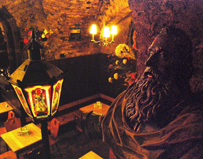 The Zwolf Apostelkeller (Twelve Apostles’ Cellar) takes up three
vaulted Romanesque basements on upper and lower levels which
go
back
as far as the 1100s, underneath a baroque building on Sonnenfelsgasse
two blocks north from St. Stephens Cathedral called the Hildebrandthaus,
named for its 18th Century builder, Lucas von Hildebrandt. The cellars
predate the building above and were reconstructed in the
1300’s
in gothic style and again in 1561. They served as public shelters during
the Turkish sieges
The Zwolf Apostelkeller (Twelve Apostles’ Cellar) takes up three
vaulted Romanesque basements on upper and lower levels which
go
back
as far as the 1100s, underneath a baroque building on Sonnenfelsgasse
two blocks north from St. Stephens Cathedral called the Hildebrandthaus,
named for its 18th Century builder, Lucas von Hildebrandt. The cellars
predate the building above and were reconstructed in the
1300’s
in gothic style and again in 1561. They served as public shelters during
the Turkish sieges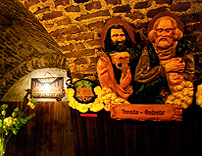 of the city in the 1500’s. The cellars became
a pub and restaurant in 1952, named for the figures of the twelve apostles
who adorn the brick caverns walls, each with their own tables in cozy
booths. As you enter down the stairs you are greeted first by a statue
of St. Paul, whose availability from a church restoration began the slightly
irreverent but fun concept of this unique tavern, but don’t expect
him to hand you a menu or show you to a table. He is still a saint after
all.
of the city in the 1500’s. The cellars became
a pub and restaurant in 1952, named for the figures of the twelve apostles
who adorn the brick caverns walls, each with their own tables in cozy
booths. As you enter down the stairs you are greeted first by a statue
of St. Paul, whose availability from a church restoration began the slightly
irreverent but fun concept of this unique tavern, but don’t expect
him to hand you a menu or show you to a table. He is still a saint after
all.
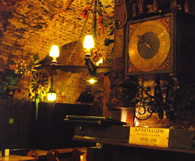 The Twelve Apostles Cellar has been a popular meeting place for artists,
poets, painters and musicians of Vienna. The food menu is traditional
Viennese for lunch and dinner, and features Austrian wines and beer.
Live traditional Viennese music is played some evening and weekends.
The Twelve Apostles is more traditional candlelight old world cozy
rather than young or hip, but can get a bit rollicking under
the watchful apostolic
eyes of its namesakes. And check your drinking hours against the ancient
Apostelurh clock - the Zwolfapostelkeller is only open until midnight. © Bargain
Travel Europe
The Twelve Apostles Cellar has been a popular meeting place for artists,
poets, painters and musicians of Vienna. The food menu is traditional
Viennese for lunch and dinner, and features Austrian wines and beer.
Live traditional Viennese music is played some evening and weekends.
The Twelve Apostles is more traditional candlelight old world cozy
rather than young or hip, but can get a bit rollicking under
the watchful apostolic
eyes of its namesakes. And check your drinking hours against the ancient
Apostelurh clock - the Zwolfapostelkeller is only open until midnight. © Bargain
Travel Europe
Find best hotel and travel deals in Vienna on TripAdvisor
Web Info
Vienna Tourism
These articles are copyrighted and the sole property of Bargain Travel Europe and WLPV, LLC. and may not be copied or reprinted without permission.
SEE ALSO:
DEMEL CAFE & CONFECTIONARY VIENNA

